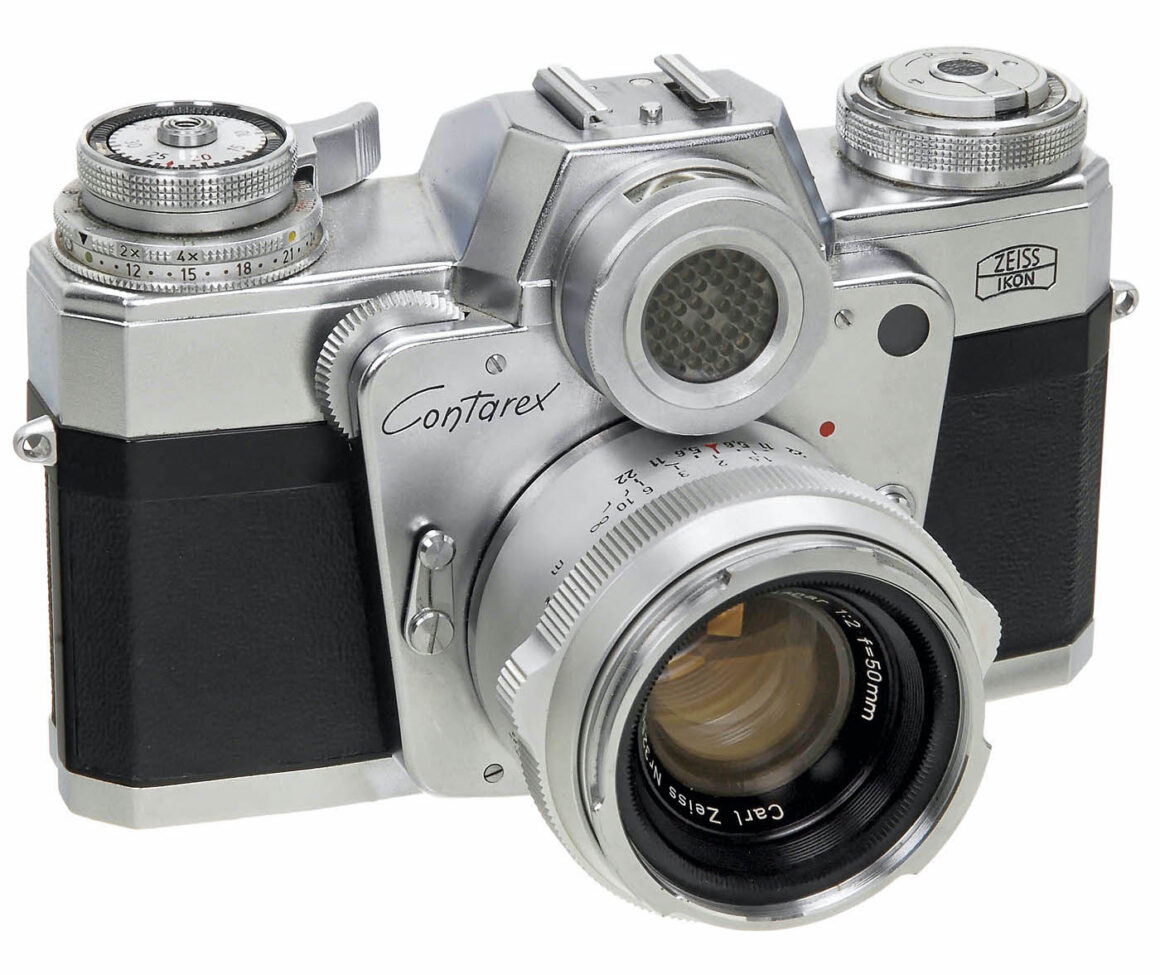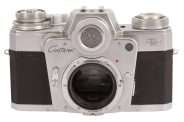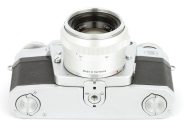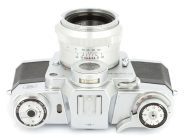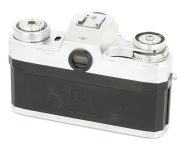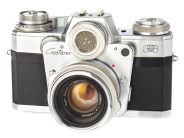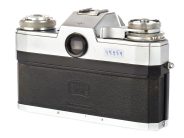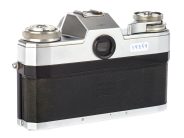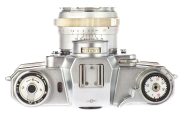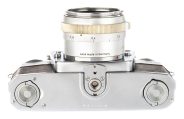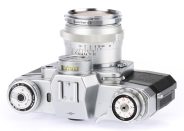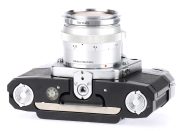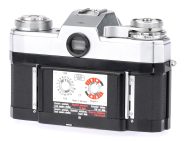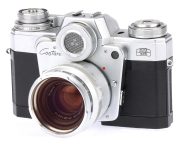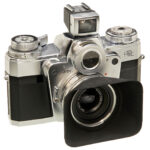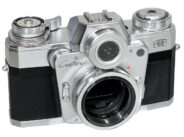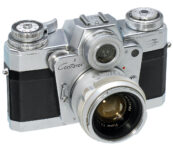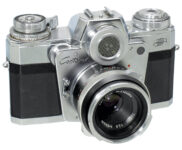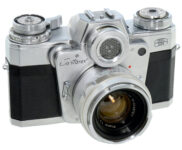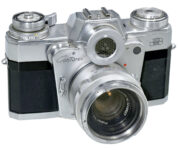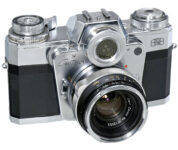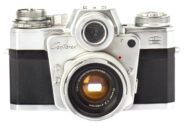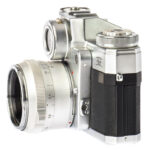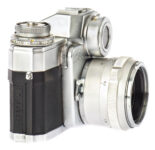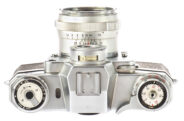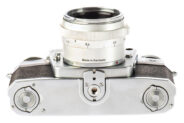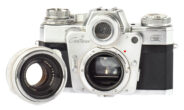Zeiss Ikon Contarex
35mm MF film SLR camera
Specification
| Production details: | |
| Announced: | September 1958 |
| System: | ● Contarex (1958) |
| Format: | |
| Maximum format: | 35mm full frame |
| Film type: | 135 cartridge-loaded film |
| Mount and Flange focal distance: | Contarex [46mm] |
| Shutter: | |
| Type: | Focal-plane |
| Model: | Mechanical |
| Speeds: | 1 - 1/1000 + B |
| Exposure: | |
| Exposure metering: | Through the separate window |
| Exposure modes: | Aperture-priority Auto |
| Shutter-priority Auto | |
| Manual | |
| Physical characteristics: | |
| Weight: | 900g |
| Dimensions: | 152.4x101.6x63.5mm |
Manufacturer description #1
Acclaimed as a striking achievement in 35mm camera design. A new high in versatility, automatic operation and precision control.
Contarex, with its standard Planar f/2, 50mm lens is ideal for a great variety of subjects. Five additional Zeiss lenses provide virtually unlimited range - from wide-angle coverage of 90 deg. to striking telephoto pictures taken at an angle of only 10 deg. Just a few accessories are required for micro and macro photography.
Light meter has unique interlock which lets you pre-select either the shutter speed or lens opening for automatic exposure control. Normall loss of light at close distances is automatically compensated for in the lens. To intentionally over or under expose, you simply disengage the interlock.
Exposure meter has provision for reflected and incident light readings. Its sensitivity can be increased 16 times by simply removing the baffle.
Viewfinder gives natural size image of incredible brightness, and incorporates a split-image rangefinder in ground-glass ring for ultra sharp focusing.
Focal-plane shutter has speeds to 1/1000 sec. and is fully synchronized. Each speed is color coded and synchronization adjusts automatically as a speed is selected.
Manufacturer description #2
The CONTAREX is a new conception in camera design obtained by combining the best features of the Contaflex and the Contax to form a new type of camera with the advantages of both: in fact a camera with a new approach to practical photography. It has taken some two years of development work for the ZEISS IKON designers to turn this idea into an accomplished fact. Some 2,450 engineering drawings with over 25,000 measurements and specifications covering every detail of the CONTAREX were needed, and the result surpassed all expectations: the novel features and improvements in the CONTAREX put it in a class of its own among single-lens reflex cameras.
Following the perfection of every detail of the CONTAREX design, it is now in full production. Every CONTAREX consists of some 1,100 individual parts - not counting the lens! - and needs almost 4,000 tooling operations with an accuracy to 0.001 mm. (1 /25,000 of an inch). Carefully selected and specially trained mechanics guarantee the highest ZEISS IKON precision workmanship, from the body casting to the final assembly.
That is why every CONTAREX is a special achievement in modern camera manufacture.
You will rarely find a subject - pictorial or scientific - that the CONTAREX cannot handle with utmost precision. And some of the unusual features of the interchangeable lenses are of special advantage. For instance, the 35 mm. DISTAGON and the 50 mm. PLANAR lenses include automatic compensation for the change in effective aperture due to the extension at close distances. Interchangeable lenses with smaller lens openings than f/2 automatically stop the built-in exposure meter down to the available iris opening and supplementary focusing bellows permit close-ups down to 2 1/2 times magnification on the film.
As a result of careful planning the CONTAREX owner requires very few accessories.
There is only one special viewfinder for the f/4.5, 21 mm. BIOGON super wide-angle lens, for instance.
Before a CONTAREX is despatched, it must pass through nearly 80 tests in the final inspection. ZEISS IKON experts have developed special ultra-modern instruments for these tests. The exact shutter speeds, for instance, are determined electronically with a crystal controlled oscillator.
LENS
Standard CONTAREX lens is 2" (50 mm.) ZEISS PLANAR f/2 (or 55 mm. Planar f/1.4). This 6-element lens with an angle of view of 45° was designed by Dr. Paul Rudolph, the inventorof the world-famous ZEISS TESSAR. lt has an amazingly flat field and is considered one of the world's leading lenses. All CARL ZEISS lenses for the CONTAREX are outstanding, i.e. they are carefully matched with regard to colour correction, with the result that each lens performs equally well from the point of colour rendering and picture quality. All lenses interchangeable by bayonet mount... range of 6 focal lengths available from 21 mm. to 250 mm.
VIEWFINDER/RANGEFINDER
CONTAREX pentagonal prism gives an erect and laterally correct viewing image. There are no parallax errors as is the case with the normal type of twin lens reflex... actual image seen on the screen comes out in the CONTAREX negative, sharp and brilliant right into the corners. Circular focusing screen and split-image rangefinder form two independent focusing systems. The subject can be followed in the finder right up to the moment of exposure... as soon as the exposure is made the mirror automatically returns to the viewing position.
ULTRA-SENSITIVE COUPLED EXPOSURE METER
The coupled exposure meter can be set for film speeds up to 1350 ASA, it is more sensitive than most exposure meters and gives exact readings even in very poor light. With the light-baffle removed, the sensitivity is increased by four lens stops. The exposure meter is controlled by a convenient setting wheel, and the needle is visible adjacent to the viewfinder field as well as on top of the camera body. The exposure meter is coupled automatically with the shutter but if necessary the interlock between the exposure meter and the shutter can be disengaged.
FIRST METER-COUPLED FOCAL PLANE SHUTTER/IRIS CONTROL
The CONTAREX focal plane shutter coupled to the exposure meter is unique. A single setting adjusts both exposure time and aperture. The focal plane shutter provides speeds of 1, 1/2, 1/4, 1/8, 1/15, 1/30, 1/60, 1/125, 1/250, 1/500, 1/1,000. For flash use the synchronisation is automatically adjusted as you select the shutter speed, both for flash bulbs and electronic flash. Built-in self-timer with adjustable time delay.
RAPID WINDING LEVER
One stroke of the lever advances the film, winds the shutter, fully opens the lens diaphragm, and advances the frame counter.
SHUTTER RELEASE
Falls conveniently to hand on top of camera body. Release cannot be depressed until film is advanced, unintentional double exposures impossible.
ACCESSORY SHOE
On top of camera body.
REWIND MECHANISM
By folding crank, normally flush, for fast rewinding.
FILM TRACK
Accurately made to permit use of interchangeable backs.
BODY
Zeiss Ikon precision die cast construction built for a lifetime of reliable service. Finish black leather for comfortable handling with durable satin chrome trim.
Manufacturer description #3
The Contarex is the top-ranking Zeiss Ikon camera, a camera of distinction in performance as well as in appearance. It combines the features of two leading designs: the famous Contax with completely interchangeable lens mount and the unique Contaflex single-lens reflex camera. Needless to say, such a combination of two outstanding camera designs sets new standards in versatility, precision and convenience, and it lends prestige to its owner.
The Contarex camera is designed for the most rugged conditions, made of carefully selected materials and finished to utmost perfection. It is a piece of equipment you will admire for its workmanship and dependability. Its versatility makes it the ideal tool for the advanced and discriminating photographer. With a complete set of lenses, you cover anything from 90 degree wide-angle pictures to amazing telephoto shots. Photomicrography, macro photography and copy work can be done with a few inexpensive accessories. There are indeed numerous applications for the Contarex in medical, industrial, news, studio and sports photography.
The unique single-lens reflex principle
With a single-lens reflex camera you sight and focus through the camera lens, and it does not matter if it is a standard, wide-angle or telephoto lens. In addition, you can fit a supplementary close-up lens or any other attachments over the lens, and the viewfinder image will still be parallax corrected. You also retain the convenience of the built-in rangefinder, the most important advantage of the single-lens reflex camera over regular 35mm cameras. In the Contarex, this single-lens reflex principle has been brought to unsurpassed perfection.
The camera body
A strong, die-cast body, from a light metal alloy, makes Contarex impervious to all kinds of climatic conditions. Outside metal parts are black anodized or satin chrome finished for greater durability. The camera body is handsomely covered with fine morocco leather. For fast loading and easy cleaning, the camera back is completely removable. The Contarex without lens weighs 32 ounces and measures 2 1/2 x 4 x 6", a truly compact, well proportioned and perfectly balanced camera.
Viewfinder and rangefinder
A large parallax-corrected eye-level viewfinder provides an extra bright natural-size image, always sharp to the edges for instantaneous compositions. You see and focus through the lens, wide open. It also features an instant-return mirror which returns to viewing position after each exposure. The Penta roof-type prism makes the subject appear upright and unreversed, which is an essential point in sports photography and various other fields. The Fresnel lens guarantees an amazing overall brightness which is a necessity for available light photography. Simultaneously with viewing the subject, you focus the lens on either the split-image field or the surrounding extra fine focusing screen. This combined view and rangefinder is ideal for full-frame compositions of action shots. At the same time, you have complete control over the built-in exposure meter as the indicating needle is placed adjacent to the viewfinder image.
Exposure meter
Zeiss Ikon exposure meters have proved to be most reliable for over 25 years, and the Contarex meter is, indeed, outstanding in performance as well as in its special features. Built into the camera for protection and for greater convenience, this exposure meter couples to all interchangeable lenses with automatic preset diaphragms (35mm to 135mm). The ingenious interlock system gives the choice of pre-selecting either a shutter speed or a lens opening, and the other setting is then adjusted with the exposure meter. Most other single-lens reflex cameras do not provide this alternative, and with these designs, the shutter speed must be pre-selected at all times. The Contarex exposure meter also permits conventional shutter speed and f/stop setting for non-preset lenses (21mm and 250mm). Furthermore, the automatic interlock can be temporarily disengaged to use individual settings for deliberate under or over-exposure (green dot setting). There are provisions for reflected and incident light readings.
To increase the sensitivity of this exposure meter under poor lighting conditions, simply remove the light baffle in front of the photocell, and the exposure meter will be 16x more sensitive than under ordinary conditions. This is equivalent to four full lens stops (yellow dot setting). The exposure meter can be adjusted at waist level or eye level. The indicating needle is adjacent to the viewfinder image. The 35mm Distagon and 50mm Planar automatically compensate for the natural loss of light at near distances.
The focal plane shutter
There are 12 shutter speed settings on a single dial, including B, 1-1/1000 sec., and each speed operates with amazing smoothness. The built-in self-timer can be adjusted to various time delays, and the shutter is fully synchronized fo flash bulbs and electronic flash units. Each speed is color coded and you adjust the synchronization automatically as you select a particular shutter speed.
Color code for flash synchronization
Black speeds (X-contact) 1-1/30 sec: Class M bulbs, electronic flash units.
Yellow speed (X-contact) 1/60 sec: Electronic flash units only.
Red speeds (M-contact) 1/125-1/1000 sec: Focal plane (FP) flash bulbs.
All speeds from 1-1/1000 sec. operate with the built-in self-timer for flash exposures.
Rapid film advance lever
One stroke with this lever advances film, cocks shutter, then opens lens diaphragm and shutter blades for viewing.
Rapid rewind crank
A collapsible crank permits fast rewinding of 20 or 36 exposure loads into the cartridge.
Manufacturer description #4
The name ZEISS IKON is synonymous with photography because ZEISS IKON has contributed with innumerable inventions and many new technical developments to the rapid growth of the photographic industry and has been a pioneer in revolutionary camera designs over several decades.
Among the great achievements of the world-renowned ZEISS IKON organization, the CONTAREX camera ranks first. This model is the ultimate in perfection of 35 mm single-lens reflex cameras.
The CONTAREX is a remarkable technological achievement. lts brllliant peformance is quickly appreciated by the photographer, for it easily handles the most difficult photographic problems of the amateur, the professional, or the scientist. The CONTAREX has more built-in features and advantages than many cameras offer as additional accessories.
New ! Sensational automatic flash control
Flash without calculation! What could be easier - adjust the focusing and the aperture is automatically set. Special stops are fitted to the ring which effectively prevent any setting being made which would result in under or over exposure. This system works just as efficiently with expendable flashbulbs as with electronic flash.
This unique ZEISS IKON feature is fitted to both the ZEISS B-PLANAR f/2, 50 mm and the ZEISS B-DISTAGON f/4, 35 mm - the most suitable lenses for flash photography.
The Viewfinder System
The picture is always seen as it appears on the final print or slide.
NEW! The standard focusing screen with split-image rangefinder can now be interchanged with a plain ground-glass screen or a clear-glass screen with engraved cross-lines. When it is a question of judging the overall image sharpness (important for close-up and macrophotography) the ground-glass screen will be found extremely useful. The clear-glass screen is recommended for photomicrography. There is a special focusing screen with split-image rangefinder and ground-glass ring for 250 mm and longer telephoto lenses.
Whether photomicrograph, close-up or telephoto shot, the CONTAREX finder always displays the exact framing of the sublect - radiantly bright, sharp, upright, unimpeded and perfectly free from parallax.
The CONTAREX embodies two focusing systems, a split-image rangefinder and a ground glass ring. The operation of the two is simultaneous. Focusing subjects with clean vertical lines is easiest when the split-image rangefinder is used, while the ground glass is ideal for focusing on subjects of a more uniform pattern - lattices, fishing nets, etc. With either system precise focusing is simply and rapidly achieved.
The pointer of the coupled exposure meter appears at the side of the viewfinder image. lt does not interfere with subject observation and is easily adjusted while using the viewfinder.
The instant return mirror is another enhancing feature. lmmediately after the shutter is released, the subject reappears in the viewfinder. In short, the simple to use viewfinder system of the CONTAREX is your guarantee of picture perfection.
Exposure Automation
For the very first time! A focal-plane shutter is coupled with built-in exposure meter.
The CONTAREX is the first camera with focal plane shutter ever produced in which shutter speed and aperture settings are coupled with the exposure meter. You can pre-select either setting (shutter speed or aperture) and then find the other setting by lining up the exposure meter pointer in the viewfinder. For special work, the exposure meter can be quickly uncoupled.
The CONTAREX exposure meter has an unusually wide metering range. In most cases, it is used for reflected light readings. By simply removing a light baffle in front of the photo-electric cell, the meter can be converted to incident-light readings. This will also make the exposure meter 16 times more sensitive than with a light baffle, a special advantage for measuring in extremely poor light. The pointer of the exposure meter can be seen in the viewfinder, as well as in a window on top of the camera body. This built-in exposure meter is extremely dependable under all kinds of conditions.
Available shutter speed settings range from 1 to 1/1000th of a second, including B. The delayed-action device can be adjusted from two to ten seconds. The CONTAREX shutter is fully synchronized for flashbulbs and electronic flash. M or X type synchronization is automatically selected as you set a shutter speed. To guard against possible errors in flash synchronization, all shutter speed settings are colorcoded.
Ease of Operation
Conveniently located controls guarantee fast operation
1. The CONTAREX is designed to offer maximum readiness for action shots. Rapid wind lever, exposure meter adjustment, shutter speed settings and focusing are always at your finger tips for instant operation or last-minute corrections.
2. When using the CONTAREX at waist-level, all important camera scales and dials such as shutter speed, aperture, focusing, depth of field, frame counter, film type inclicator, and exposure meter pointer can be checked at a glance without moving the camera.
3. A handy rewind crank speeds up rewinding of exposed film and reduces your reloading time considerably. There's much less chance of you missing a picture wth the CONTAREX.
The viewfinder is designed so that most spectacles wearers can see the entire field of view without removing their glasses. There are also corrective lenses available for those who wish to adapt the viewfinder to their own eye prescription.
The frame counter indicates the number of unexposed frames.
No calculations are required to determine the number of pictures remaining. This holds true regardless of the number of exposures in the magazine.
The Interchangeable magazine back
From Black-and-White to Color in a few seconds
Every amateur has experienced the disappointment of missing a perfect color shot because his camera was loaded with black-and-white film; or when there was a good opportunity for a good artificial light shot, his camera was loaded with daylight film.
Those disappointments are over. The novel interchangeable back for the CONTAREX makes it possible to exchange partially exposed rolls of film in seconds, in full daylight and without the loss of a single frame!
The interchangeable back provides a flexibility which heretofore was obtainable only by using additional camera bodies. With interchangeable backs you save the cost of complete camera bodies and have less equipment to carry.
In industrial and scientific photography, several lab technicians may use the same camera. By using interchangeable backs they can retain their film and have it processed at their own convenience.
Manufacturer description #5
The Contarex by ZEISS IKON AG. Stuttgart is a single-lens miniature reflex camera for the 24x36mm negative format. The camera has a parallax-free viewfinder, a photo-electric exposure meter coupled to the focal-plane shutter, a rapid film wind lever and interchangeable lenses.
The CONTAREX is a most suitable instrument for the professional photographer, the scientist, the press photographer, the technician and also for the discriminating amateur, all of whom will be able to obtain excellent photographs with it even under the most difficult conditions. The viewfinder will always show the upright and laterally correct image which will be depicted on the film no matter which lens is used. This applies also for close-ups, close-up magnifications, photo-micrographic ond other specialised work. The reflected image seen through the taking lens will always be completely free from parallax.
Many practical accessories widen the scope of the camera in all fields of photography; in short, the CONTAREX is an extremely versatile camera which meets all requirements, since even the most diificult photographic problems can be solved with its aid, with amazing speed and simplicity.
The special features of the C0NTAREX
All the advantages of both the famous ZEISS IKON cameras, the CONTAX and the CONTAFLEX are combined in the CONTAREX. The most popular features of the CONTAREX are these:
- The all-metal die-cast body which ensures the highest possible precision and rigidity.
- The built-in photo-electric exposure meter with its wide measuring range and colour-corrected photo-cell.
- The automatic exposure control. The diaphragm and the shutter speed settings are coupled to the exposure indicator in such a way that, starting with one component, the other one is determined automatically. The indicator can be seen in the viewfinder adjacent to the actual finder image and, in addition, also on top of the CONTAREX.
- The parallax-free reflex viewfinder with its bright, large, uniformly-illuminated image field and two types of rangefinder: a split-image rangefinder and a micro raster ring, which are both coupled to the focusing device.
- The interchangeable CARL ZEISS lenses which have been especially computed for the CONTAREX, are in rapid-change bayonet mounts. The range of interchangeable lenses extends from the 21 mm super-wide-angle lens to those of extremely long focal lengths. The CONTAREX lenses from 35 mm to 135 mm have pre-set spring-diaphragms which are coupled to th exposure meter.
- The shutter speeds from 1 sec. to 1/1000 sec. and "B" for time exposures can be set with a ring and are also coupled to the exposure meter.
- The focal-plane shutter runs smoothly and is free from vibration. It is synchronized for both flashbulbs and electronic flash and automatically selects the correct moment of ignition if the shutter speed is correctly set for the type of flash in use. A delayed action device is built into the shutter.
- All settings - distance, aperture, depth of field, shutter speed and exposure indication can be read off from above at a single glance.
- Standard 35 mm miniature film is used with the CONTAREX, in the form either of commercial cartridges or daylight-refills in CONTAREX cassettes, which can also be used with bulk film or darkroom refills.
- The twin-cassette system makes it possible to remove the film without rewinding. Black-and-white and colour films can also be exchanged without rewinding.
- The detachable back helps considerably in dusting and cleaning the spool chambers and makes loading and unloading an easy matter.
- Only a few accessories are needed to simplify the mastering of difficult photographic tasks, such as close-ups, close-up magnifications, photomicrography, copying and tele-photo pictures.
- The highest possible precision in the mechanical construction, the unsurpassed efficiency of the lenses and the absolute reliability of the built-in exposure meter make the CONTAREX the top-ranking camera for the professional photographer, the scientist, the technician and the discriminating amateur.
From the editor
The Contarex was announced at the Photokina 1958, but it took an year (September 1959) to hit the dealer's shelves. The camera had many greatly admired features, but also had a tremendous drawback. It weighted 900g without a lens, and you could add another 230g for the new standard Planar lens. It did not sell particularly well because of the great weight and high price - due in part to the need for skilled hand assembly of all the complex parts (the camera contained more than a thousand individual parts).
But there was also new competition from Japan. There cameras were smaller, more compact and had fairly aggressive new lens systems as well. Yes, the Zeiss lenses were still remarkably better than those of the competition but, for the money, the Japanese combination of less expensive cameras and lenses were thought to be a better value. These new cameras were rapidly approaching the Contarex in their features, with the Nikon F of 1960 being particularly successful.
The original Contarex was upgraded in February 1964 to use interchangeable focusing screens as well as a data strip accessory, which allowed a small message about the exposure or subject to appear on the negative.
